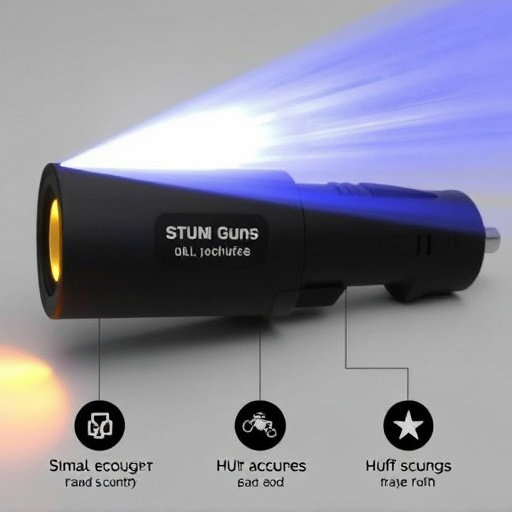Stun guns, or electronic control devices (ECDs), are self-defense tools that incapacitate attackers through high-voltage, low-current electric pulses disrupting the nervous system. Their effectiveness depends on clothing material and thickness, with conductive fabrics allowing complete voltage passage while insulating fabrics obstruct it. Thicker materials pose greater resistance to current. Risks associated with stun guns include improper voltage penetration through thick fabric, potentially harming both user and target. Proper training, manufacturer guidelines, maintenance, using as a last resort, awareness of local laws, and protective gear are essential safety measures. Understanding voltage penetration is crucial for law enforcement and self-defense applications, emphasizing the need to assess scenarios and choose the right tool based on clothing or armor.
Voltage penetration through thick clothing is a critical aspect of understanding the effectiveness of stun guns. This article delves into the science behind stun gun technology, exploring how electrical shocks are delivered and what factors, such as material and thickness, influence their penetration. We examine safety considerations and practical applications in law enforcement and self-defense, while also discussing limitations. By understanding how these weapons work, users can make informed decisions regarding their use.
- Understanding Stun Gun Technology: Unveiling the Science Behind Shock Delivery
- The Effect of Material and Thickness on Voltage Penetration
- Safety Considerations: Risks and Mitigation Strategies
- Practical Applications: Law Enforcement, Self-Defense, and Limitations
Understanding Stun Gun Technology: Unveiling the Science Behind Shock Delivery
Stun guns, also known as electronic control devices (ECDs), are designed to incapacitate an assailant through electrical shock, temporarily rendering them immobile. Understanding how a stun gun works is crucial to appreciating its effectiveness in self-defense scenarios. At its core, a stun gun delivers a high-voltage, low-current electric pulse to the body of the target. This pulse disrupts the normal functioning of the nervous system, causing muscles to contract uncontrollably and leading to a loss of balance and consciousness.
The technology behind stun guns involves specialized circuits that generate a controlled electrical charge. When activated, these circuits produce an electrical field strong enough to penetrate clothing and deliver a shock. The intensity of the shock is adjustable, with higher settings capable of penetrating thicker fabrics and providing a more powerful incapacitating effect. This versatility makes stun guns a popular choice for personal protection, as users can adapt the device’s output based on the situation and the clothing worn by the assailant.
The Effect of Material and Thickness on Voltage Penetration
The effectiveness of voltage penetration through thick clothing varies significantly based on the material and its thickness. Different fabrics have distinct electrical properties that influence how easily electric current can pass through them. For instance, conducting materials like metal allow for almost complete voltage penetration, while insulating materials such as cotton or leather significantly impede it.
The thickness of the fabric plays a crucial role as well. As the material gets thicker, the resistance to voltage increases. This is why stun guns, which deliver high-voltage electrical discharges, may struggle to penetrate heavy fabrics like thick denim or canvas. Understanding these factors is essential when considering personal safety equipment, such as how a stun gun works in different scenarios.
Safety Considerations: Risks and Mitigation Strategies
When considering the safety aspects of voltage penetration through thick clothing, it’s crucial to understand the risks associated with weapons like stun guns. A stun gun delivers an electric shock through a metal probe or contacts, disrupting muscle control in the target by temporarily depolarizing their nerve cells. However, this energy transfer can be significantly reduced when the weapon comes into contact with fabric. The thick material acts as insulation, creating a barrier that dampens the current, which could lower the effectiveness of the stun and potentially pose a safety hazard to both the user and the intended target.
To mitigate these risks, users must prioritize proper training and adhere to manufacturer guidelines when deploying such devices. Ensuring clear understanding of how a stun gun works, including its limitations, is paramount. Users should also take precautions like maintaining regular maintenance of their equipment, using them only as a last resort, and being aware of local laws regarding their possession and use. Additionally, wearing protective gear or targeting less insulated body areas when possible can enhance safety measures against voltage penetration through thick clothing.
Practical Applications: Law Enforcement, Self-Defense, and Limitations
In practical applications, law enforcement and self-defense are two primary areas where understanding voltage penetration through thick clothing becomes relevant. Stun guns, also known as electronic control devices (ECDs), operate by delivering high-voltage, low-current electrical pulses to disrupt muscle control in a target, rendering them temporarily incapacitated. However, the effectiveness of a stun gun can be influenced by various factors, including the thickness and material of clothing worn by the subject. While some materials may offer better protection against conventional weapons, they can also affect how a stun gun’s electric current travels through the body. For law enforcement officers, this knowledge is crucial for safe and effective use during high-risk situations.
Despite their utility, there are limitations to consider. Thicker clothing can significantly reduce the penetration depth of the electrical pulses, potentially leading to a less reliable immobilization. Additionally, materials like metal or highly conductive fabrics can even conduct electricity away from the targeted area, further diminishing the stun gun’s effectiveness. These factors underscore the importance of assessing the situation and choosing the appropriate tool for each scenario, especially when dealing with individuals wearing protective clothing or armor.
Understanding how a stun gun works involves grasping the science behind voltage penetration through thick clothing. The effectiveness of stun guns depends heavily on material composition and thickness, with certain fabrics and materials providing more resistance than others. Safety considerations are paramount, as improper use can lead to risks and adverse effects. Despite limitations, practical applications in law enforcement and self-defense make stun guns valuable tools when used appropriately. By considering these factors, users can navigate the complexities of stun gun technology for enhanced safety and effectiveness.
